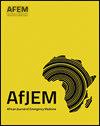Perceptions, availability and use of vasopressors for septic shock in emergency care settings in Tanzania
IF 1.2
4区 医学
Q3 EMERGENCY MEDICINE
引用次数: 0
Abstract
Background
Sepsis carries a disproportionately high mortality in Sub-Saharan Africa. Current international guidelines for management of septic shock advocate for initial fluid resuscitation followed by vasopressors if there is ongoing concern for hypoperfusion. Emerging data suggest patients in sub-Saharan Africa who receives large fluid boluses may have increased mortality and thus earlier initiation of vasopressors may have clinical benefit. Little data exists on the perceptions, availability and use of vasopressors in Tanzania, which may impact the feasibility of this strategy. We aimed to describe the perception, availability and use of vasopressor in Tanzanian emergency care settings, including its barriers.
Methods
We conducted a cross-sectional web-based survey among clinicians and nurses from 19 different hospitals throughout Tanzania (national, zonal, regional and district hospitals). Collected data was kept by the principal investigator on a password encrypted computer whereby descriptive statistics were used to summarize the results.
Results
Sixty-five healthcare providers completed the survey of whom the majority 53 (81.5 %), work in the emergency medicine department and 50 (76.9 %) reported treating at least one patient with septic shock per week. However, three quarters of respondents from district hospitals and nearly half of those from regional hospitals had access to vasopressors in <50 % of the time. The most common reported barriers to vasopressor use were lack of availability (50.8 %), and lack of comfort or knowledge (43.1 %). Overall, most respondents perceived that vasopressor use is generally safe and helpful for treating septic shock.
Conclusions
Nearly all Tanzanian healthcare providers in emergency care settings reported that they had limited access to vasopressors to treat septic shock, as it was not consistently available. In addition to unavailability, lack of knowledge on vasopressor use was also reported as barrier. Our findings suggest that ensuring availability of vasopressors and education in the use thereof would improve sepsis care in Tanzanian hospitals.
在坦桑尼亚的紧急护理环境中,对感染性休克血管加压药的认识、可得性和使用
在撒哈拉以南非洲,败血症的死亡率高得不成比例。目前的国际感染性休克管理指南主张,如果持续担心灌注不足,应进行初始液体复苏,然后使用血管加压剂。新出现的数据表明,撒哈拉以南非洲接受大剂量液体治疗的患者死亡率可能增加,因此早期开始使用血管加压药物可能具有临床益处。关于坦桑尼亚血管加压剂的认知、可得性和使用情况的数据很少,这可能会影响这一战略的可行性。我们的目的是描述感知,可用性和使用血管加压药在坦桑尼亚的紧急护理设置,包括其障碍。方法我们对坦桑尼亚19家不同医院(国家、地区、区域和区级医院)的临床医生和护士进行了一项基于网络的横断面调查。收集的数据由首席研究员保存在密码加密的计算机上,并使用描述性统计来总结结果。结果65名医护人员完成了调查,其中53名(81.5%)在急诊科工作,50名(76.9%)报告每周至少治疗1例脓毒性休克患者。然而,四分之三来自地区医院的应答者和近一半来自区域医院的应答者在50%的时间内获得血管加压药。最常见的使用血管加压素的障碍是缺乏可用性(50.8%),以及缺乏舒适性或知识(43.1%)。总的来说,大多数应答者认为血管加压素的使用通常是安全的,有助于治疗感染性休克。结论:几乎所有坦桑尼亚紧急护理机构的医疗服务提供者都报告说,他们使用血管加压剂治疗感染性休克的机会有限,因为这种药物并不总是可用的。除了无法获得外,缺乏血管加压素使用知识也被报道为障碍。我们的研究结果表明,确保血管加压药的可用性和使用血管加压药的教育将改善坦桑尼亚医院的败血症护理。
本文章由计算机程序翻译,如有差异,请以英文原文为准。
求助全文
约1分钟内获得全文
求助全文
来源期刊

African Journal of Emergency Medicine
EMERGENCY MEDICINE-
CiteScore
2.40
自引率
7.70%
发文量
78
审稿时长
85 days
 求助内容:
求助内容: 应助结果提醒方式:
应助结果提醒方式:


